Freely Available British and Irish Public Legal Information
[Home] [Databases] [World Law] [Multidatabase Search] [Help] [Feedback]
United Kingdom Statutory Instruments
You are here: BAILII >> Databases >> United Kingdom Statutory Instruments >> The RAF Welford Byelaws 2010 No. 1104
URL: http://www.bailii.org/uk/legis/num_reg/2010/uksi_20101104_en_1.html
[New search] [Help]
The RAF Welford Byelaws 2010
Made
24th March 2010
Coming into force
1st July 2010
The Secretary of State for Defence, in exercise of the powers conferred on him by section 14(1) of the Military Lands Act 1892(1) and having complied with the consultation requirements of section 17(1) of that Act, makes the following byelaws:
Citation and commencement
1. These byelaws may be cited as the RAF Welford Byelaws 2010 and shall come into force on 1st July 2010.
Revocation
2. The Royal Air Force Welford Byelaws 1988(2) are revoked.
Interpretation
3. In these byelaws:
"aircraft" includes any craft or device which is for the time being airborne;
"Appointed Person" means the Crown servant who has been appointed by the Secretary of State to be responsible for the Protected Area and the Controlled Areas;
"Controlled Areas" means the areas of land belonging to the Secretary of State that are coloured blue on the five maps annexed to these byelaws;
"firearm" has the same meaning as in the Firearms Act 1968(3)
"lawful user" means any constable, Crown servant, member of a visiting force or headquarters, or any person in possession of a written permission from the Appointed Person;
"offensive weapon" means any article made or adapted for use for:
causing injury to, or incapacitating a person, or
causing injury to, or incapacitating or trapping an animal or bird, and
the person having it with him intends it for such use, or for threatening such use;
"Protected Area" means the area of land that is coloured pink on the five maps annexed to these byelaws;
"service authorities" means naval, military or air force authorities;
"visiting force" means any body, contingent or detachment of the forces of a country for the time being present in the United Kingdom on the invitation of Her Majesty´s Government and any civilian component of that force as defined in section 10 of the Visiting Forces Act 1952(4).
Application of Byelaws
4. These byelaws apply to the Protected Area and the Controlled Areas.
Prohibited Activities - Protected Area
5. No person shall:
(a) enter or leave the Protected Area except by way of an official entrance or exit;
(b) remain in the Protected Area after having been directed to leave by a constable or person described in byelaw 11;
(c) obstruct a lawful user acting in the proper exercise of his duty within the Protected Area;
(d) cause or permit any vehicle, craft, aircraft, animal or thing to enter into the Protected Area;
(e) take any photograph of any person or thing whilst within the Protected Area;
(f) make any false statement, either orally or in writing, or employ any other form of misrepresentation in order to obtain entry to any part of the Protected Area;
(g) board or interfere with the movement of any vehicle within the Protected Area;
(h) interfere with, or obstruct the use of, any property within the Protected Area which is under the control of the Crown or the service authorities of a visiting force or in either case its agents or contractors;
(i) remove any property which is under the control of the Crown or the service authorities of a visiting force or in either case its agents or contractors;
(j) deface any sign, wall, fence, structure or other surface within the Protected Area.
Use of the Controlled Areas by the Public
6. Subject to the provisions of these byelaws, members of the public are permitted to use all parts of the Controlled Areas not specifically enclosed or entry to which is not shown by signs or fences as being prohibited or restricted, for any lawful purpose at all times when the Controlled Areas are not being used for the military purpose for which they have been appropriated.
Prohibited Activities - Controlled Areas
7. No person shall within the Controlled Areas:
(a) obstruct a lawful user or any other person acting in the proper exercise of their duty;
(b) enter any part which is enclosed or entry to which is shown as by a sign as being prohibited or restricted;
(c) carry any firearm or offensive weapon;
(d) interfere with, or obstruct the use of, any property which is under the control of the Crown, or the service authorities of a visiting force or in either case its agents or contractors;
(e) remove any property which is under the control of the Crown, or the service authorities of a visiting force or in either case its agents or contractors;
(f) camp in tents, caravans, trees or otherwise;
(g) cause any nuisance, or behave in an indecent or obscene manner;
(h) deposit any refuse, rubble, waste or litter or abandon any vehicle or vehicle part or other article;
(i) act in any way likely to cause annoyance, nuisance or injury to other persons;
(j) light any fire or do anything likely to cause an outbreak of fire;
(k) fail to keep under control any dog or other animal;
(l) (fail to keep any dog on a short lead during the period beginning with 1st March and ending with 31st July in each year;
(m) fail to remove all waste created by any dog or other animal under their control;
(n) deface any sign, wall, fence, structure or other surface;
(o) engage in any trade or business of any description or ride, drive, conduct or cause to be ridden, driven or conducted, use or employ any animal or vehicle of any kind or use any audible means either wholly or mainly for the purpose of trade or advertisement;
(p) damage, cut or remove any crops, turfs, plants, roots or trees;
(q) graze any animal;
(r) kill or trap any birds or animals, or take or destroy their eggs; or
(s) dig or search for any item, or interfere with or take any item found within the Controlled Areas.
Contravention of Byelaws
8. Any person who contravenes or attempts to contravene byelaws 5 or 7 shall commit an offence under section 17(2) of the Military Lands Act 1892.
Exemptions
9. These byelaws shall not apply to anything done by:
(a) a lawful user in connection with the discharge of his functions; or
(b) a person acting under and in accordance with any permission given in writing by the Appointed Person.
Enforcement
10. In order to:
(a) prevent the breach of any provision of byelaws 5 or 7; or
(b) prevent any nuisance, disorder, obstruction or damage to the land or any property within the Protected Area and the Controlled Areas;
a constable or person described in byelaw 11 may direct any person to leave, or to remove any vehicle, aircraft, animal, or thing from the Protected Area and the Controlled Areas and any person to whom such a direction is made shall comply with it as soon as practicable.
11. The following persons are authorised to remove from the Protected Area and the Controlled Areas and to take into custody without warrant any person committing an offence against these byelaws and to remove any vehicle, aircraft, animal or thing in contravention of these byelaws from the said areas:
(a) The Appointed Person;
(b) Any officer, warrant officer, or non - commissioned officer in uniform and acting under the instructions of the Appointed Person; and
(c) Any other Crown servant authorised in writing by the Appointed Person.
Kevan Jones
Parliamentary Under Secretary of State
Ministry of Defence
24th March 2010
SCHEDULE

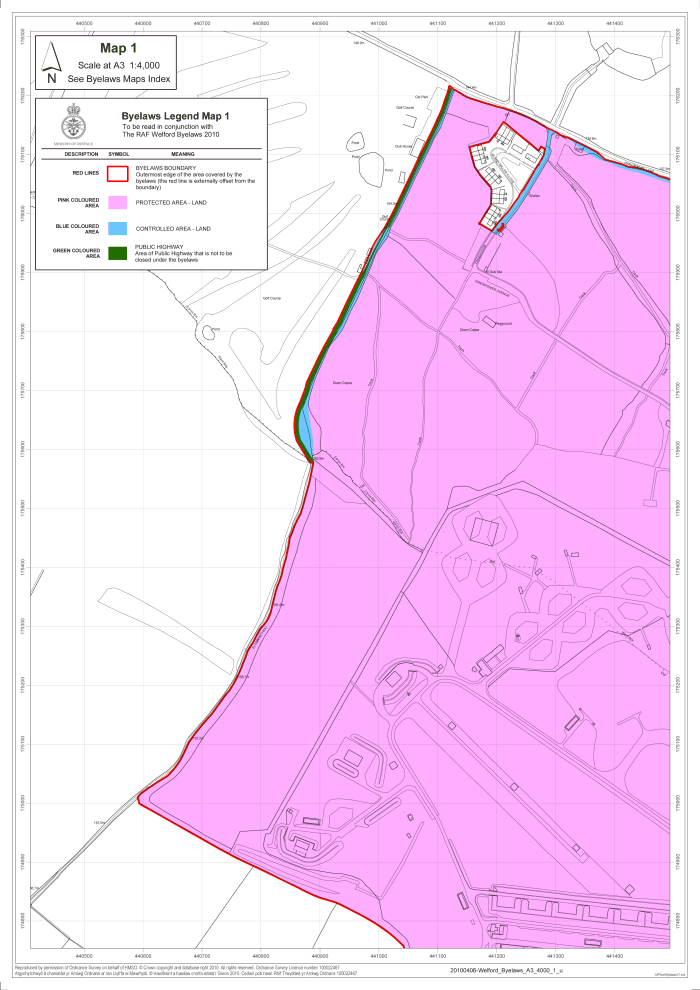
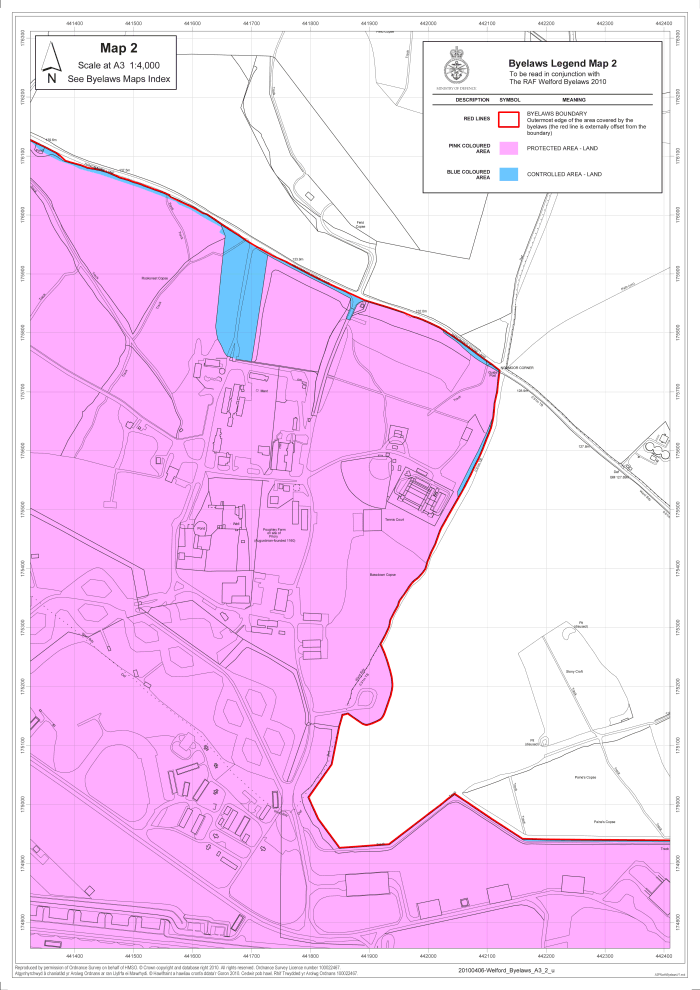
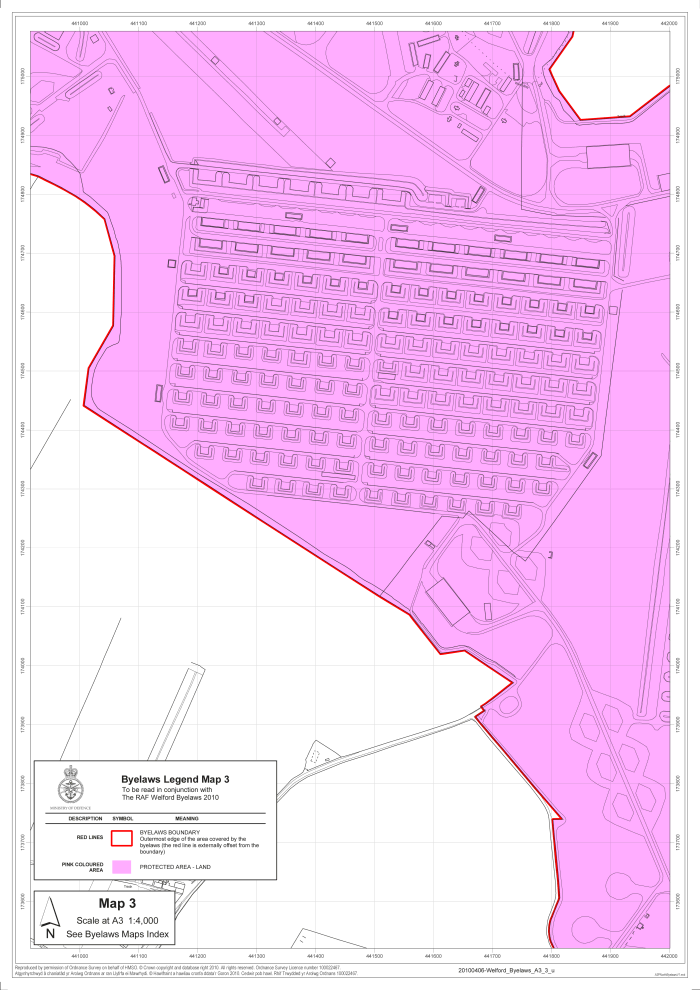
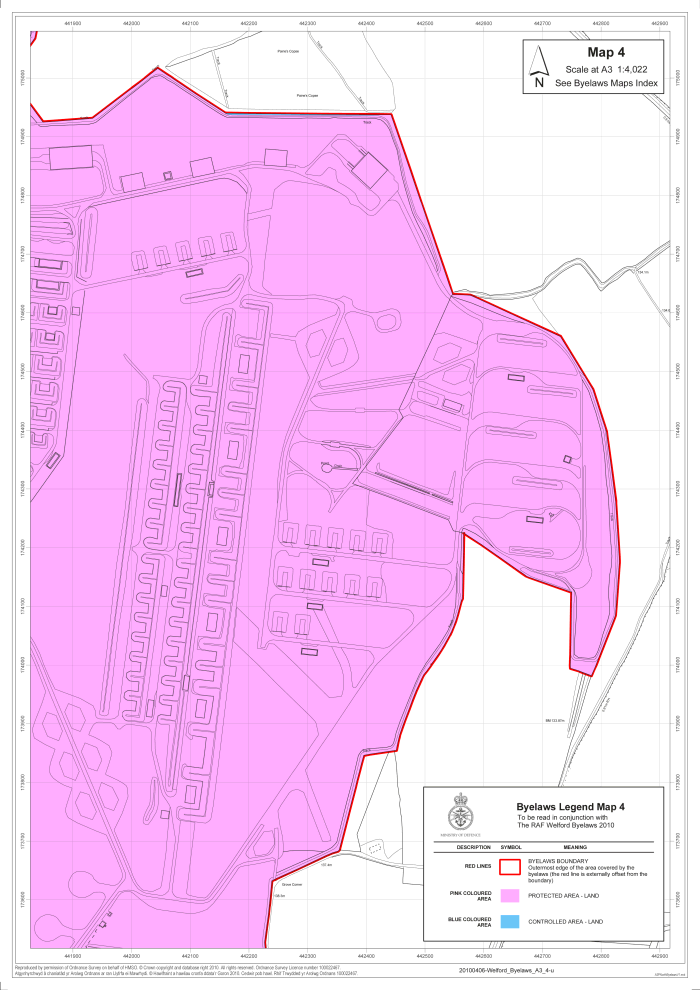
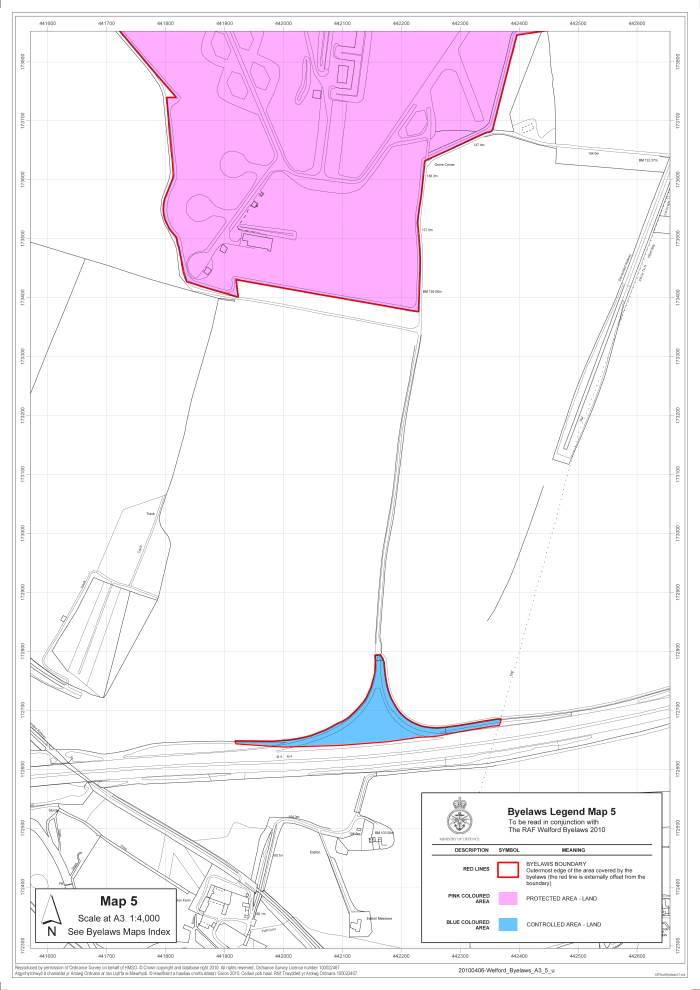
EXPLANATORY NOTE
(This note is not part of the Byelaws)
Part II of the Military Lands Act 1892 (c.43) provides for the making of byelaws for regulating the use of land held for military purposes and securing the safety of the public. These byelaws regulate the land at RAF Welford.
The land subject to these byelaws, together the Protected Area and the Controlled Areas, comprise the land held under title numbers BK 408062, BK 232917, BK 199468 and BK 376137 that are registered at the Land Registry, Gloucester Office, Twyver House, Bruton Way, Gloucester GL1 1DQ.
A copy of these byelaws and a plan showing the Protected Area and Controlled Areas to which these byelaws apply may be inspected on the Ministry of Defence website http://www.mod.uk/DefenceIntranet/Microsite/DE/WhatWeDo/Byelaws/. Copies may also be inspected at the Great Shefford Village Shop and Post Office, The Mead, Great Shefford, Hungerford, Berks RG17 7DB; Newbury Central Library, The Wharf, Newbury, Berks RG14 5AU; Hungerford Library, Church Street, Hungerford RG27 0JG; Lambourn Library, High Street, Lambourn, Hungerford RG17 8XL and on signboards erected locally. Copies may be obtained from the Librarian, Defence Estates, Kingston Road, Sutton Coldfield B75 7RL.
By virtue of section 17(2) of the Military Lands Act 1892, any person who commits an offence against any byelaw under this Act is liable on conviction before a court of summary jurisdiction to a fine not exceeding level 2 on the standard scale. At the time of printing the maximum fine payable is therefore five hundred pounds (£500).
